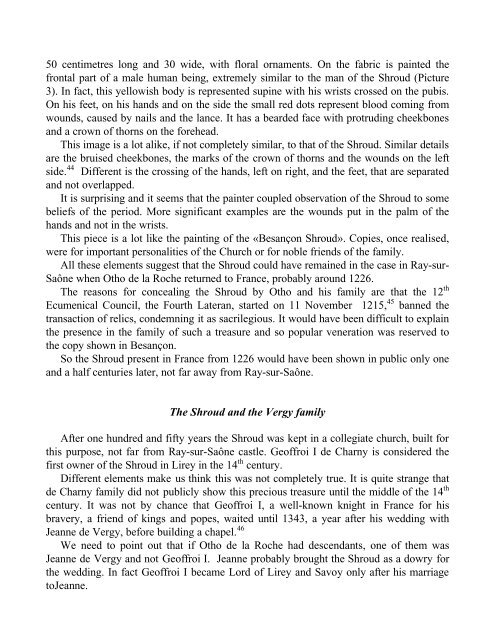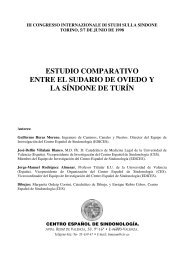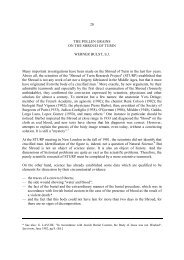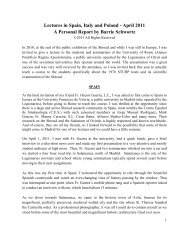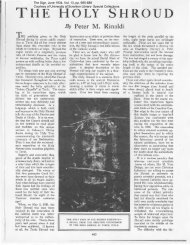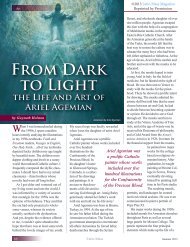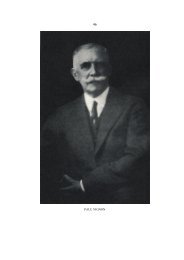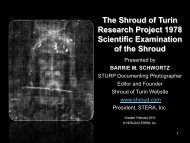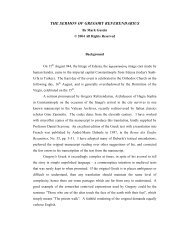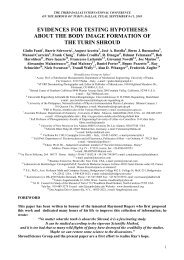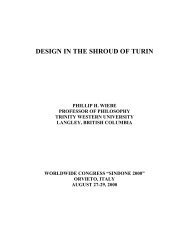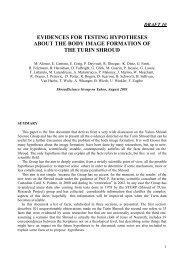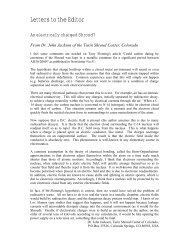Missing Years - Shroud of Turin
Missing Years - Shroud of Turin
Missing Years - Shroud of Turin
You also want an ePaper? Increase the reach of your titles
YUMPU automatically turns print PDFs into web optimized ePapers that Google loves.
50 centimetres long and 30 wide, with floral ornaments. On the fabric is painted the<br />
frontal part <strong>of</strong> a male human being, extremely similar to the man <strong>of</strong> the <strong>Shroud</strong> (Picture<br />
3). In fact, this yellowish body is represented supine with his wrists crossed on the pubis.<br />
On his feet, on his hands and on the side the small red dots represent blood coming from<br />
wounds, caused by nails and the lance. It has a bearded face with protruding cheekbones<br />
and a crown <strong>of</strong> thorns on the forehead.<br />
This image is a lot alike, if not completely similar, to that <strong>of</strong> the <strong>Shroud</strong>. Similar details<br />
are the bruised cheekbones, the marks <strong>of</strong> the crown <strong>of</strong> thorns and the wounds on the left<br />
side. 44 Different is the crossing <strong>of</strong> the hands, left on right, and the feet, that are separated<br />
and not overlapped.<br />
It is surprising and it seems that the painter coupled observation <strong>of</strong> the <strong>Shroud</strong> to some<br />
beliefs <strong>of</strong> the period. More significant examples are the wounds put in the palm <strong>of</strong> the<br />
hands and not in the wrists.<br />
This piece is a lot like the painting <strong>of</strong> the «Besançon <strong>Shroud</strong>». Copies, once realised,<br />
were for important personalities <strong>of</strong> the Church or for noble friends <strong>of</strong> the family.<br />
All these elements suggest that the <strong>Shroud</strong> could have remained in the case in Ray-sur-<br />
Saône when Otho de la Roche returned to France, probably around 1226.<br />
The reasons for concealing the <strong>Shroud</strong> by Otho and his family are that the 12 th<br />
Ecumenical Council, the Fourth Lateran, started on 11 November 1215, 45 banned the<br />
transaction <strong>of</strong> relics, condemning it as sacrilegious. It would have been difficult to explain<br />
the presence in the family <strong>of</strong> such a treasure and so popular veneration was reserved to<br />
the copy shown in Besançon.<br />
So the <strong>Shroud</strong> present in France from 1226 would have been shown in public only one<br />
and a half centuries later, not far away from Ray-sur-Saône.<br />
The <strong>Shroud</strong> and the Vergy family<br />
After one hundred and fifty years the <strong>Shroud</strong> was kept in a collegiate church, built for<br />
this purpose, not far from Ray-sur-Saône castle. Ge<strong>of</strong>froi I de Charny is considered the<br />
first owner <strong>of</strong> the <strong>Shroud</strong> in Lirey in the 14 th century.<br />
Different elements make us think this was not completely true. It is quite strange that<br />
de Charny family did not publicly show this precious treasure until the middle <strong>of</strong> the 14 th<br />
century. It was not by chance that Ge<strong>of</strong>froi I, a well-known knight in France for his<br />
bravery, a friend <strong>of</strong> kings and popes, waited until 1343, a year after his wedding with<br />
Jeanne de Vergy, before building a chapel. 46<br />
We need to point out that if Otho de la Roche had descendants, one <strong>of</strong> them was<br />
Jeanne de Vergy and not Ge<strong>of</strong>froi I. Jeanne probably brought the <strong>Shroud</strong> as a dowry for<br />
the wedding. In fact Ge<strong>of</strong>froi I became Lord <strong>of</strong> Lirey and Savoy only after his marriage<br />
toJeanne.


